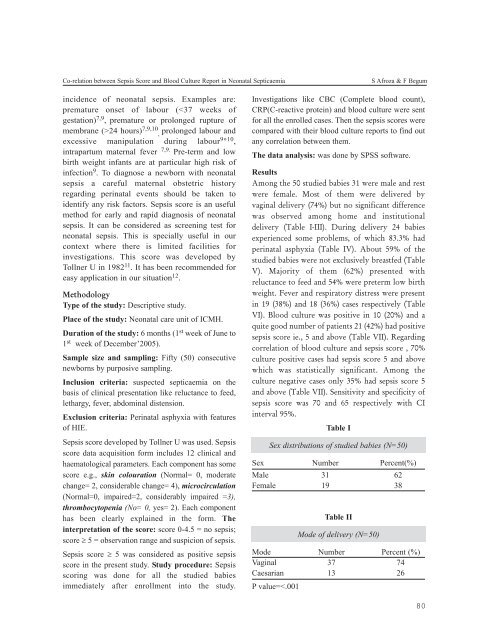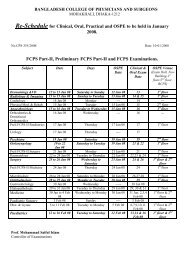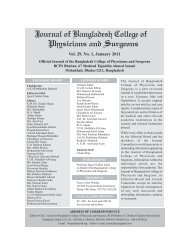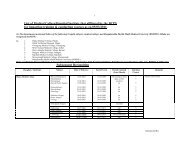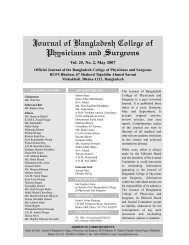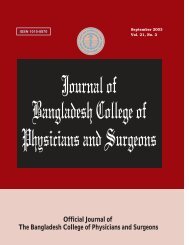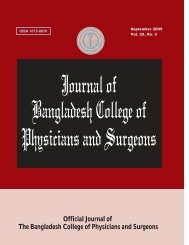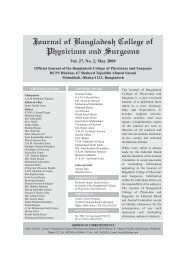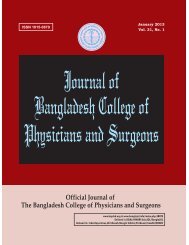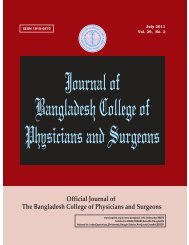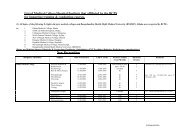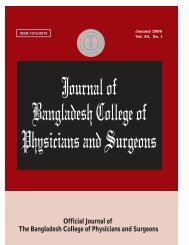May 2008 - bcps
May 2008 - bcps
May 2008 - bcps
Create successful ePaper yourself
Turn your PDF publications into a flip-book with our unique Google optimized e-Paper software.
Co-relation between Sepsis Score and Blood Culture Report in Neonatal SepticaemiaS Afroza & F Begumincidence of neonatal sepsis. Examples are:premature onset of labour (24 hours) 7,9,10 ,prolonged labour andexcessive manipulation during labour 9 ° 10 ,intrapartum maternal fever 7,9. Pre-term and lowbirth weight infants are at particular high risk ofinfection 9 . To diagnose a newborn with neonatalsepsis a careful maternal obstetric historyregarding perinatal events should be taken toidentify any risk factors. Sepsis score is an usefulmethod for early and rapid diagnosis of neonatalsepsis. It can be considered as screening test forneonatal sepsis. This is specially useful in ourcontext where there is limited facilities forinvestigations. This score was developed byTollner U in 1982 11 . It has been recommended foreasy application in our situation 12 .MethodologyType of the study: Descriptive study.Place of the study: Neonatal care unit of ICMH.Duration of the study: 6 months (1 st week of June to1 st week of December’2005).Sample size and sampling: Fifty (50) consecutivenewborns by purposive sampling.Inclusion criteria: suspected septicaemia on thebasis of clinical presentation like reluctance to feed,lethargy, fever, abdominal distension.Exclusion criteria: Perinatal asphyxia with featuresof HIE.Sepsis score developed by Tollner U was used. Sepsisscore data acquisition form includes 12 clinical andhaematological parameters. Each component has somescore e.g., skin colouration (Normal= 0, moderatechange= 2, considerable change= 4), microcirculation(Normal=0, impaired=2, considerably impaired =3),thrombocytopenia (No= 0, yes= 2). Each componenthas been clearly explained in the form. Theinterpretation of the score: score 0-4.5 = no sepsis;score ≥ 5 = observation range and suspicion of sepsis.Sepsis score ≥ 5 was considered as positive sepsisscore in the present study. Study procedure: Sepsisscoring was done for all the studied babiesimmediately after enrollment into the study.Investigations like CBC (Complete blood count),CRP(C-reactive protein) and blood culture were sentfor all the enrolled cases. Then the sepsis scores werecompared with their blood culture reports to find outany correlation between them.The data analysis: was done by SPSS software.ResultsAmong the 50 studied babies 31 were male and restwere female. Most of them were delivered byvaginal delivery (74%) but no significant differencewas observed among home and institutionaldelivery (Table I-III). During delivery 24 babiesexperienced some problems, of which 83.3% hadperinatal asphyxia (Table IV). About 59% of thestudied babies were not exclusively breastfed (TableV). Majority of them (62%) presented withreluctance to feed and 54% were preterm low birthweight. Fever and respiratory distress were presentin 19 (38%) and 18 (36%) cases respectively (TableVI). Blood culture was positive in 10 (20%) and aquite good number of patients 21 (42%) had positivesepsis score ie., 5 and above (Table VII). Regardingcorrelation of blood culture and sepsis score , 70%culture positive cases had sepsis score 5 and abovewhich was statistically significant. Among theculture negative cases only 35% had sepsis score 5and above (Table VII). Sensitivity and specificity ofsepsis score was 70 and 65 respectively with CIinterval 95%.Table ISex distributions of studied babies (N=50)Sex Number Percent(%)Male 31 62Female 19 38Table IIMode of delivery (N=50)Mode Number Percent (%)Vaginal 37 74Caesarian 13 26P value=


